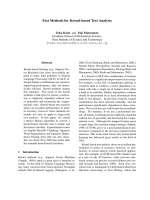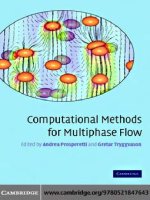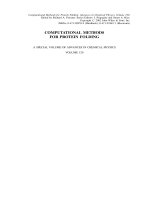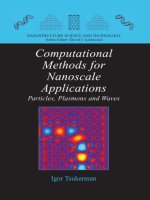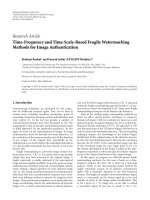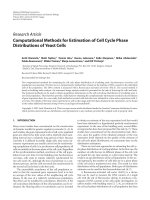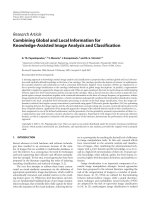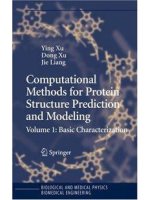Computational methods for structure activity relationship analysis and activity prediction
Bạn đang xem bản rút gọn của tài liệu. Xem và tải ngay bản đầy đủ của tài liệu tại đây (8.93 MB, 146 trang )
Computational Methods for
Structure-Activity Relationship
Analysis and Activity Prediction
Kumulative Dissertation
zur Erlangung des Doktorgrades (Dr. rer. nat.)
der Mathematisch-Naturwissenschaftlichen Fakult¨at
der Rheinischen Friedrich-Wilhelms-Universit¨at Bonn
vorgelegt von
Disha Gupta-Ostermann
aus Kota, Indien
Bonn
May, 2015
Angefertigt mit Genehmigung der
Mathematisch-Naturwissenschaftliche Fakult¨at der Rheinischen
Friedrich-Wilhelms-Universit¨at Bonn
1. Referent: Univ.-Prof. Dr. rer. nat. J¨
urgen Bajorath
2. Referent: Univ.-Prof. Dr. rer. nat. Michael G¨
utschow
Tag der Promotion: 20 October, 2015
Erscheinungsjahr: 2015
Abstract
Structure-activity relationship (SAR) analysis of small bioactive compounds
is a key task in medicinal chemistry. Traditionally, SARs were established on
a case-by-case basis. However, with the arrival of high-throughput screening
(HTS) and synthesis techniques, a surge in the size and structural heterogeneity
of compound data is seen and the use of computational methods to analyse
SARs has become imperative and valuable.
In recent years, graphical methods have gained prominence for analysing
SARs. The choice of molecular representation and the method of assessing
similarities affects the outcome of the SAR analysis. Thus, alternative methods providing distinct points of view of SARs are required. In this thesis, a
novel graphical representation utilizing the canonical scaffold-skeleton definition to explore meaningful global and local SAR patterns in compound data is
introduced.
Furthermore, efforts have been made to go beyond descriptive SAR analysis
offered by the graphical methods. SAR features inferred from descriptive methods are utilized for compound activity predictions. In this context, a data structure called SAR matrix (SARM), which is reminiscent of conventional R-group
tables, is utilized. SARMs suggest many virtual compounds that represent as
of yet unexplored chemical space. These virtual compounds are candidates for
further exploration but are too many to prioritize simply on the basis of visual
inspection. Conceptually different approaches to enable systematic compound
prediction and prioritization are introduced. Much emphasis is put on evolving
the predictive ability for prospective compound design. Going beyond SAR
analysis, the SARM method has also been adapted to navigate multi-target
spaces primarily for analysing compound promiscuity patterns. Thus, the original SARM methodology has been further developed for a variety of medicinal
chemistry and chemogenomics applications.
Acknowledgments
I would like to express deep gratitude to my supervisor Prof. Dr. J¨
urgen
Bajorath for providing me with this excellent opportunity to pursue the doctoral
studies and for his constant guidance and support.
I thank Prof. Dr. Michael G¨
utschow for reviewing my thesis as a co-referent. I
also thank Prof. Dr. Thorsten Lang and Prof. Dr. Thomas Schultz for being
members of the review committee.
I extend my gratitude to all the colleagues of the LSI group for providing a nice
working and learning atmosphere. I further thank Jenny Balfer, Dr. Ye Hu and
Dr. Vigneshwaran Namasivayam for the fruitful collaborations. Special thanks
to the lunch group for all the fun times spent in the Mensa.
I would like to thank Boehringer Ingelheim for supporting this thesis. Especially
I’d like to thank Dr. Peter Haebel and Dr. Nils Weskamp for the helpful
discussions and their hospitality.
Further, I would like to thank my family for showering their love on me. Finally,
I would like to thank Bj¨orn and his family, for being a persistent support during
my studies.
Contents
1 Introduction
1
Molecular Representations and Similarity . . . . . . . . . . . . . . . .
1
SAR Analysis Methods . . . . . . . . . . . . . . . . . . . . . . . . . .
8
Activity Landscapes . . . . . . . . . . . . . . . . . . . . . . . . . . .
9
Multi-Target Activity Spaces . . . . . . . . . . . . . . . . . . . . . .
18
Thesis Outline
19
. . . . . . . . . . . . . . . . . . . . . . . . . . . . . .
References
23
2 Introducing the LASSO Graph for Compound Data Set Representation and Structure-Activity Relationship Analysis
31
Introduction . . . . . . . . . . . . . . . . . . . . . . . . . . . . . . . .
31
Publication . . . . . . . . . . . . . . . . . . . . . . . . . . . . . . . .
32
Summary . . . . . . . . . . . . . . . . . . . . . . . . . . . . . . . . .
41
3 Second Generation SAR Matrices
43
Introduction . . . . . . . . . . . . . . . . . . . . . . . . . . . . . . . .
43
Publication . . . . . . . . . . . . . . . . . . . . . . . . . . . . . . . .
45
Summary . . . . . . . . . . . . . . . . . . . . . . . . . . . . . . . . .
59
4 Systematic Mining of Analog Series with Related Core Structures in Multi-Target Activity Space
61
Introduction . . . . . . . . . . . . . . . . . . . . . . . . . . . . . . . .
61
Publication . . . . . . . . . . . . . . . . . . . . . . . . . . . . . . . .
63
Summary . . . . . . . . . . . . . . . . . . . . . . . . . . . . . . . . .
73
i
CONTENTS
5 Neighborhood-Based Prediction
from SAR Matrices
Introduction . . . . . . . . . . . . . .
Publication . . . . . . . . . . . . . .
Summary . . . . . . . . . . . . . . .
of Novel Active Compounds
. . . . . . . . . . . . . . . . . .
. . . . . . . . . . . . . . . . . .
. . . . . . . . . . . . . . . . . .
6 Hit Expansion from Screening Data Based
Probabilities of Activity Derived from SAR
Introduction . . . . . . . . . . . . . . . . . . . . .
Publication . . . . . . . . . . . . . . . . . . . . .
Summary . . . . . . . . . . . . . . . . . . . . . .
7 Prospective Compound Design using the
Conditional Probabilities of Activity
Introduction . . . . . . . . . . . . . . . . . . .
Publication . . . . . . . . . . . . . . . . . . .
Summary . . . . . . . . . . . . . . . . . . . .
75
75
77
87
upon Conditional
Matrices
89
. . . . . . . . . . . 89
. . . . . . . . . . . 90
. . . . . . . . . . . 105
SAR Matrix-Derived
107
. . . . . . . . . . . . . 107
. . . . . . . . . . . . . 108
. . . . . . . . . . . . . 123
8 Conclusions
125
Additional References
129
Additional Publications
131
ii
Chapter 1
Introduction
The modern drug discovery process is a complex multistage process that focuses
on the development of novel drugs, i.e., chemical entities that elicit a desired
response in the biological system by acting on target(s) of interest. The structure of these small molecules plays an important role in their interactions with
corresponding biological target(s). Understanding the structure-activity relationships (SARs) of bioactive molecules is a key task in medicinal chemistry.1,2
Since the 1960s, computational approaches have been deployed for SAR exploration.2 A central principle that underlies SAR analysis is the “similarity
property principle” (SPP) which states that similar molecules should have similar properties.3 The description of molecular structures and the assessment of
molecular similarities is critical for conducting relevant SAR studies and obtaining meaningful results.
Molecular Representations and Similarity
The SPP principle is not easy to capture methodologically because the problem
lies in defining (dis)similarity in a consistent manner. The assessment of structural similarity of compounds depends on the computational representation of
molecules and the similarity metric. Hence, the choice of the representation
and similarity metric influences SAR analysis.4
1
CHAPTER 1. INTRODUCTION
The simplest way to represent a molecule is by its empirical formula. This
is a one-dimensional (1D) representation. However, one formula represents
multiple molecules because it does not contain structural information. Linear
notations such as Simplified Molecular Input Line Entry System (SMILES)5
have been developed, which represent the structural information of molecules
in an unambiguous, reproducible and universal manner.
A more intuitive and popular way to represent a molecule is to use its
two-dimensional (2D) molecular graph. In a graph, atoms are represented as
nodes using atomic symbols and edges correspond to bonds. Hence, the graph
represents the topology of the molecule and can be encoded in the form of a
connection table. This connection table comprises a sequential list of atoms
and a list of bonds connecting these atoms.
Molecules can also be represented in three dimensions (3D) by accounting
for the spatial arrangement of their atoms.
Molecular Descriptors
In computational medicinal chemistry, there is no gold standard by which
molecules should be represented. One of the most widely used ways is the
application of molecular descriptors. Molecular descriptors are mathematical functions that characterize structural and/or physicochemical properties
of molecules as numerical values. With the help of these numerical descriptors
computational chemical reference spaces in which molecules are projected can
be generated.6 Chemical (dis)similarity is then defined through the intermolecular distance in the space.
A large number of descriptors have been defined that vary in complexity.7
In general, descriptors can be classified based on the dimensionality of the
molecular representations from which they are calculated. For example, 1D
descriptors include molecular weight and atom counts, such as the number of
carbon or oxygen atoms. These descriptors are calculated from 1D representation of molecules (chemical formula). 2D descriptors are derived on the basis of
2D molecular graphs that characterize, for example, physicochemical or topological properties, such as octanol/water partition coefficient (logP) or various
2
CHAPTER 1. INTRODUCTION
topological indices. 3D descriptors are generated from 3D conformations, such
as pharmacophores and surface area.
Molecular Fingerprints
Apart from numerical representations of molecular structures and properties,
bit string representations are also popular. Molecular fingerprints (FPs) are
bit string representations of chemical structures and properties, which are often
encoded in binary formats. The presence and absence of a given feature in the
molecule is indicated by setting the corresponding bit to 1 and to 0, respectively.
As with numerical descriptors, FPs can be categorized into 2D or 3D depending on whether the chemical features describing the bit positions are derived
from 2D or 3D molecular graph representations. Over the past decades, various
FPs have been introduced that vary in their design, composition and length,
based on which different FP prototypes can be defined.8
FPs in which each feature is assigned to a specific bit position are called
keyed FPs. These FPs usually have fixed length, such as Molecular ACCess
System (MACCS)9 that contains 166 predefined structural fragments (substructures).
By contrast, combinatorial FPs capture layered atom environments in molecules up to a predefined bond diameter. Instead of predefined feature sets,
molecule-specific features are calculated from individual compounds and thus
the corresponding FPs would have a variable length. In addition, each feature
is hashed into an integer number that represents the final feature set for a
molecule. The most popular combinatorial FPs are the extended connectivity
FPs (ECFPs).10 An important feature of combinatorial FPs is that they capture
atom environments in a molecule.
Pharmacophore patterns can be captured by pharmacophore FPs. “Pharmacophores are 3D (or 2D) arrangement of groups (functionalities) in a compound responsible for its bioactivity”.8 In pharmacophore FPs, bit positions
are assigned to possible pharmacophore patterns encoded by conformers of a
molecule. Pharmacophore patterns are typically defined by triplet or quadruplet feature points and inter-feature distance ranges. These FPs typically con3
CHAPTER 1. INTRODUCTION
tain very large number of bit positions. A comparison of the three different
types of FPs is presented in Figure 1.1. For a common molecule three different
FP representations are encoded as bit strings.
Keyed FP
Combinatorial FP
1. Layer
2. Layer
3. Layer
...
Pharmacophore FP
c
cc(c)C
nc(N)c(C=0(N))cn)
H
11
H
5
13
H
8
5
A
D
Ar
7
Figure 1.1: Molecular fingerprints. Three different (keyed, combinatorial and pharmacophore) FP designs are shown. Structural information used to obtain the corresponding FP
representation is highlighted. Blue- and white-colored bits indicate the presence and absence,
respectively, of specific structural features or arrangements in the molecule. Taken from [8].
A number of similarity metrics are available to quantitatively assess similarity between a pair of molecular FPs.11 The underlying concept is to account
for common and distinct structural features. The most widely applied measure
is the Tanimoto coefficient (Tc)11 that counts the number of bits common to
two binary FPs with respect to the total number of unique bits that are set on
in each FP. Accordingly, the Tc for two binary FP representations A and B is
calculated as follows:
T c(A, B) =
c
a+b−c
where c is the number of bits set on in both FPs and a and b refer to the number
of bits set on in A and B, respectively. Tc value ranges between 0 and 1, where
4
CHAPTER 1. INTRODUCTION
0 corresponds to no FP overlap and 1 to identical FPs. However, it should be
noted that identical FPs do not necessarily correspond to identical molecules
because FPs are only a generalization of the molecular structures.
Depending on the FP one uses, it is very difficult to decide whether a given
Tc value indicates the presence of “significant similarity” or not.4,12 Furthermore, it is difficult to relate specific structural changes in pairs of molecules
to quantified similarity values. Thus, the FP-based similarity measure is often
difficult for medicinal chemists to use. Substructure-based representations can
be chemically more intuitive to relate SARs and guide novel compound designs.
Molecular Scaffolds
The concept of scaffolds, which is popular in medicinal chemistry, accounts for
a substructure-based representation of molecules. Scaffolds are generally used
to describe core structures of molecules that are utilized in drug design or used
as building blocks for compound synthesis.13
Many different definitions of scaffolds exist. The most widely used definition was introduced by Bemis and Murcko.14 Bemis and Murcko (BM) scaffolds
are generated by removing all side chains from the molecules and retaining
ring systems and linkers. This enables the consistent generation of scaffolds
and provides a sound basis for molecular framework-based SAR analysis. Following this definition, multiple BM scaffolds with minor differences in their
heteroatoms and/or bond orders, are considered structurally distinct. BM scaffolds can be further abstracted to “cyclic skeletons” (CSKs)15 by changing each
heteroatom to carbon and setting all double, triple and aromatic bonds to single bonds. Thus, topologically equivalent BM scaffolds are represented by a
common CSK. Figure 1.2 illustrates the compound-scaffold-skeleton hierarchy.
Each scaffold represents one or more compounds and each CSK covers one or
more scaffolds that share the same topology.
BM scaffolds and CSKs have been used to analyze the diversity of known
drugs13,14 and SAR trends in compound data.16,17 However, the hierarchical
scaffold definition has limitations. For example, the addition of a ring to an
existing BM scaffold creates per definition a distinct BM scaffold even though
5
CHAPTER 1. INTRODUCTION
such modifications are commonly applied during lead optimization.13 Moreover,
the nature and properties of substituents attached to the scaffolds that often
influence the SARs are not accounted for. Hence, an alternative representation
is required that accounts for well-defined substructural relationships.
Compound
BM Scaffold
CSK
Figure 1.2: Molecular framework A schematic diagram of the hierarchical generation of
Bemis and Murcko (BM) scaffolds and cyclic skeleton (CSK) from three compounds is shown.
BM scaffolds (red) are generated by removing all side chains and retaining only the rings and
linkers of the compounds. BM scaffolds are further converted to CSK by substituting all
heteroatoms to carbon and setting bond orders to one.
Matched Molecular Pairs
Substructural relationships between pairs of compounds can be elegantly captured by the concept of matched molecular pairs (MMPs).18 An MMP is a
pair of compounds that share a large substructure and differ by a structural
change (R-group) at a common site.18 An exemplary MMP is given in Figure
1.3. The MMP formalism provides a consistent and well-defined framework
to assess structural similarity. It helps in correlating structural changes to activity/property changes in a systematic manner as compared to FPs or BM
scaffolds. The MMP concept has gained wide recognition in the medicinal
chemistry field.19
6
CHAPTER 1. INTRODUCTION
MMP
Transformation
Figure 1.3: Matched molecular pair. A pair of compounds that forms a matched
molecular pair (MMP) is shown. The exchanged substituent is highlighted in red and the
corresponding transformation is depicted at the bottom.
Different algorithms that systematically extract MMPs from compound data
sets are available. Some algorithms utilize direct graph comparison like maximum common substructure (MCS) search between pairs of molecules.20 The
MCS search is an NP-hard problem21 and requires comparison of molecules in
a pairwise manner.22 Other algorithms involve fragmenting molecules into substructures on the basis of pre-defined rules.23 The fragmentation step is complemented by subsequent indexing of the identified fragments. The fragmentation
is carried out systematically on all single acyclic bonds present between two
non-hydrogen atoms in a molecule. The resulting larger fragments are stored
as keys and the remaining smaller fragments as values in the index table. If
a key fragment already exists, the corresponding value fragment is added to
the value list. Thus, the key fragment corresponds to the common substructure shared between the two molecules and the value fragments correspond to
the exchange of a pair of substructures, termed chemical transformations,23 as
shown in Figure 1.3. The fragmentation approach is computationally more efficient for large-scale MMP extraction than MCS search. Furthermore, the MMP
definition has also been extended to include chemical changes at more than one
position by fragmenting molecules at multiple acyclic bonds (typically up to
three).19
7
CHAPTER 1. INTRODUCTION
In order to assess compound pairs that are only distinguished by a functional group or a single ring system “transformation size-restricted MMPs”
have been introduced.24 Such MMPs are useful for correlating small structural
modifications to activity/property changes.
A recent work has introduced the concept of “fuzzy matched pairs” (FMP)25
that combines the classical MMP definition with a pharmacophore description.
This enables the analysis of compound pairs with transformations that are
structurally distinct but share a pharmacophore.
The methods described in this section are different ways to represent molecules
and assess their similarity. Each method has its own advantages and limitations.
The exploration of SARs is affected by the choice of the representation and the
similarity metric. Other factors, such as the origin, composition and size of the
compound data set under investigation also affect the analysis of SARs. These
factors need to be considered when choosing the method for the analysis of
SARs.
SAR Analysis Methods
Current computational approaches to study SARs are multifaceted and of different methodological complexity. In general, the methodologies could be classified as descriptive or predictive. Descriptive approaches mine the SAR information from the data and then represent it numerically or graphically. The
represented SARs can then be analyzed by medicinal chemists. Predictive approaches extract generalized SAR patterns from the reference compounds to
predict biological activities of new compounds.4
The field referred to as quantitative SAR (QSAR) analysis, was first developed by Hansch et al.26 and has been invaluable for understanding SARs. In
QSAR, a mathematical model is derived that relates structural features and/or
molecular properties to bioactivity. QSAR models are built from a set of compounds with known biological activity. These models can be applied to predict
8
CHAPTER 1. INTRODUCTION
activities of candidate molecules with a structural/chemical composition similar to that of the reference compounds. Candidate compounds that are not
reasonably similar to some reference compounds fall outside the applicability
domain of the model and their activity cannot be reliably predicted.27
Over the years, QSAR modeling has evolved from applications using relatively simple linear regression methods to more complex non-linear machine
learning techniques.28 However, even in the presence of similar compounds these
methods fail to reliably predict activities of the candidate compounds in many
cases.29 Outliers result not only from statistical fluctuations or measurement
errors but also from the limitation on the part of the SPP principle underlying
these approaches. SPP is intuitive and a central paradigm in medicinal chemistry, however, it is frequently observed that small modifications in chemical
structures can lead to dramatic changes in compound activity.29 Pairs of compounds that show high structural similarity and significant difference in activity
are called activity cliffs 29 and represent exceptions to the SPP principle.
These observations suggest that there are fundamental differences in the
nature of SARs. To deconvolute the complex SAR patterns in the data, descriptive approaches have been used. These methods guide compound design
in hit-to-lead and lead optimization campaigns by enabling the user to understand on a case-by-case basis the structural features that determine activity. A
conventional data structure called R-group table that displays the substituents
of individual compounds and their corresponding compound activity is useful
to study the effect of small structural changes on compound potency. However, R-group tables are applied to analogs that share the same core structure
and are not suitable to analyze large compound sets. Therefore, tools that
can be applied on large and structurally heterogeneous compound data sets are
indispensable.
Activity Landscapes
The descriptive approaches for SAR analysis include various data mining and
visualization methods to systematically analyze SARs on a large-scale and ex9
CHAPTER 1. INTRODUCTION
tract available SAR information from compound data sets of different sizes and
origins.30 The combination of these methods provides a basis for the exploration
of SARs.
The activity landscape concept is an approach that has become popular.4,30
An activity landscape can be defined as any graphical representation that integrates similarity and potency relationships between compounds having a specific
biological activity.4 It enables the systematic comparison of compound structures and their potencies.
The Nature of SARs
The different natures of SARs can be observed in 3D activity landscapes. A 3D
activity landscape is generated by adding activity as the third dimension to a
2D chemical reference space of a set of compounds.31 In the 2D chemical space,
inter-compound distances reflect structural (dis)similarity. Thus, compounds
that are close in the 2D space are chemically more similar than compounds
that are farther apart. The third dimension, activity, provides information
about the distribution of the compounds’ potency values. Compounds with
large or moderate differences in their potency value can be clearly observed.
The activity landscape view resembles geographical landscapes, and contains
similar features, e.g. plains, mountains and valleys.
In 3D representations, gently sloped areas, as shown in Figure 1.4a, represent regions of SAR continuity where gradual changes in chemical structure are
accompanied by small or moderate changes in potency.2,4 By contrast, rugged
areas, as shown in Figure 1.4b, represent regions of local SAR discontinuity
where small modifications in chemical structures lead to large changes in potency.2,4 In these regions high peaks correspond to activity cliffs. Activity cliffs
represent a prominent form of SAR discontinuity and are highly informative.
In most cases, a compound data set is represented as a “variable activity landscape”32 that is a combination of continuous and discontinuous SAR components, as shown in Figure 1.4c. Such variable activity landscapes correspond to
the presence of SAR heterogeneity.4,32
10
CHAPTER 1. INTRODUCTION
b
SAR discontinuity
activity
SAR continuity
activity
a
c
activity
SAR heterogeneity
Figure 1.4: SAR characters. Shown are model 3D activity landscapes depicting (a.
continuous, b. discontinuous, c. heterogeneous) SAR characters, respectively. For landscape
generation, compounds are projected onto a 2D chemical reference space and activity is added
as the third dimension. Taken from [4].
The continuous SAR character is a prerequisite for virtual screening or linear QSAR applications. The discontinuous SARs, especially the activity cliffs,
are exploited in lead optimization campaigns, in order to improve compound
activity.4,30 Thus, the systematic description of the different SAR characteristics, namely continuous, discontinuous and heterogeneous, helps to choose the
relevant application for analysis and/or prediction.
Numerical SAR Analysis
Complementing the activity landscape analysis, numerical functions that quantify different SAR characteristics have also been developed.33,34 These functions
are based on pairwise calculations of structure and activity similarity for data
11
CHAPTER 1. INTRODUCTION
set compounds. The SAR index (SARI)33 is a combination of the SAR continuity and SAR discontinuity scores. The SAR continuity and discontinuity scores
quantify the continuous and discontinuous characters in compound data sets,
respectively, by taking the potency difference and similarity between compound
pairs into account. The SARI score is normalized and ranges from 0 to 1. Low,
intermediate and high scores correspond to discontinuous, heterogeneous and
continuous SAR characters, respectively.
The discontinuity score component of the SARI formalism can be used to
interpret the different SAR characteristics at a global level, i.e., for activity
classes and at a more local level, i.e., for a cluster of compounds within an
activity class.35 Furthermore, a local discontinuity score can also be calculated
to assess individual compound contributions to SAR discontinuity.35
Another numerical score reported by Guha et al.34 called the structureactivity landscape index (SALI) quantifies pairs of compounds based on their
differences in activity divided by their distances in chemical space. It emphasizes pairs of structurally similar compounds with large potency differences and
is designed to detect activity cliffs in a data set.
Thus, numerical scores can be used to quantify and diagnose the different
SAR characters for compound data sets. These functions often complement the
landscape based SAR analysis. As graphical representations, the activity landscape models provide intuitive access to the SAR information of compound data
sets. However, with steadily growing numbers of active compounds, the activity landscapes become increasingly complex.36 This requires the design of other
novel graphical schemes to effectively extract SAR information. Many different
types of graphical schemes have been designed to assist in SAR analysis.
Graphical SAR Analysis
Molecular network representations have become increasingly popular for the
visualization of SAR characteristics of compound data sets. The structureactivity similarity (SAS) maps37 are one of the earliest graph-based activity
landscape representations. In SAS maps, pairwise structural and activity similarity is plotted along an xy-plane, such that each data point represents a
12
CHAPTER 1. INTRODUCTION
pairwise compound comparison. Usually FPs are used as molecular representations and the similarity is accounted for by the Tc metric. Activity similarity
is represented as the logarithmic potency difference. Thus, a large difference
corresponds to low activity similarity and a small difference to high activity
similarity.
activity similarity
HIGH
LOW
Activity cliff
region
structural similarity
HIGH
Figure 1.5: Structure-activity similarity maps. A schematic representation of an SAS
map is shown that depicts the structural and activity similarity for all compound pairs within
a data set in a scatter plot. Each compound pair is mapped to one of the four regions. The
activity cliff forming region can be identified at the bottom right section of the SAS map.
Adapted from [4].
The SAS map can be subdivided into four sections that capture different
SAR characteristics. A schematic illustration of the SAS map is presented in
Figure 1.5. The upper-left section contains pairs of compounds with high activity and low structural similarity. This region can aid in the identification
of new active scaffolds with similar activity. The upper-right region contains
compound pairs with high structural and activity similarity, corresponding to
analogs with comparable potency. The lower-left section contains compound
pairs with low structural and activity similarity and does not contain any desirable trait for further analysis. By contrast, compound pairs falling into the
13

